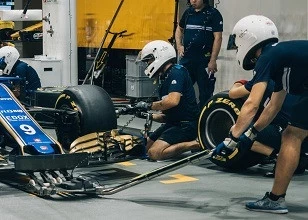Lessons for 2011: The case of Toyota and Deepwater Horizon
Add bookmarkThe worst US environmental disaster in history and a leading car maker beset by recalls – was 2010 a year that we’d all like to forget? As we launch into the first week of 2011, Process Excellence Network looks back at two of the top stories that shaped last year and the lessons learned for operational excellence practitioners.
First up, Toyota was beset by massive product recalls and damage to its reputation after questions over the safety of its cars and allegations that the company did not act quickly enough once problems had been identified.
The affair really began following the death of an off duty police officer and his family back in August 2009 after their car, a Toyota Lexus, unexpectedly accelerated, crashed into another vehicle, tumbled over an embankment and burst into flames.
Initial company reports identified that the car may have been fitted with the wrong floor mats, which could have slipped and entrapped the accelerator pedal. Following internal investigations – and combined with pressure from media and the industry regulator NHTSA - Toyota issued a recall on the floor mats of millions of cars. Another series of recalls over other issues – brake problems and sticky pedals – followed in subsequent months.
The problems began to snowball for Toyota. Critics attacked the company for allegedly covering up defects and not taking safety issues seriously enough. By February earlier this year, Toyota had issued recalls for around 10 million vehicles and its President Akio Toyoda was summoned to appear before a US Congressional Committee to respond to questions over Toyota’s handling of the recalls and safety issues.
At the time, there was a lot of handwringing about how Toyota –often seen as the gold standard in manufacturing – had lost its "way."
"That’s a perfectly natural response to the sequence of events," says Dr. Jeffrey K. Liker, PhD, professor of industrial and operations engineering at the University of Michigan and author of several books on the Toyota way. "But, that would be the wrong lesson to draw from the recalls."
Dr. Liker says that the three principle recalls (all-weather floor mats entrapping accelerators, Prius brake hesitation, and sticky pedals) "were three specific errors, rather than a pattern of poor engineering."
"From a Six Sigma point of view," he says, "if you were to do a good cause and effect analysis, you would find that there was little relationship between the actual defects, the actual numbers of vehicles recalled and the problems that were occurring within Toyota."
For instance, he says, the chief problem with all-weather floor mats entrapping accelerators was not a manufacturing defect per se, but rather a misunderstanding of how some customers would use the vehicles. The Japanese engineers hadn’t anticipated that American customers would stack the all weather mat on top of the existing mat.
But they did.
How did the engineers miss it? "The problem was that they didn’t understand the actual customer use of the product," says Liker. "The engineers understood how they thought customers should use the product, but didn’t truly understand how they actually used it."
It was a defect in understanding the customer. The company had violated one of the key Toyota Way principles: "you should have the people closest to the Gemba (customers) making the decisions and influencing the decisions." In this case, the engineers designing the product were based in Japan while the dealers who actually interacted with customers were in the US.
Since the recalls, Toyota has organized SMART (Swift Market Analysis Response Team) teams that investigate complaints firsthand, regardless of whether customer error or true manufacturing defect is at fault. Toyota has decided that if it’s a problem from the customer’s point of view, then it’s a problem.
Design and perception problems were just one of the massive problems that another big company had to contend with this year following the explosion of its Deepwater Horizon rig in the Gulf of Mexico: BP.
Following the explosion in April, millions of barrels of oil spilled into the Gulf of Mexico over a period of months, as BP and its contractors, worked with the US Coastguard to try to contain damage as it fixed the source of the problem.
The investigation into the exact series of events and decisions that lead to the disaster is still ongoing, but accusations over liability and culpability continue to fly.
BP’s four month internal investigation into the causes of the oil spill, found that "a complex and interlinked series of mechanical failures, human judgments, engineering design, operational implementation and team interfaces" had lead to the disaster.
"A sequence of failures involving a number of different parties led to the explosion and fire which killed 11 people and caused widespread pollution in the Gulf of Mexico," the company said in an accompanying press release.
But other stakeholders have tried to pin the blame squarely on BP.
"The mounting evidence clearly demonstrates that this tragedy was preventable and the direct result of BP's reckless decisions and actions," said Anadarko Chairman and CEO Jim Hackett quoted in a June 18th press release following the incident.
Hackett added in the statement that early information "indicates BP operated unsafely and failed to monitor and react to several critical warning signs during the drilling of the Macondo well. BP's behavior and actions likely represent gross negligence or willful misconduct."
Anadarko was part owner of BP’s Macondo well and under the terms of the operating agreement is partly liable for costs of the disaster unless another partner is found guilty of gross negligence.
Although the far reaching consequences and assignation of blame have only begun, oil companies say that they have begun to review their procedures to prevent a similar disaster occurring again.
Rex W. Tillerson, Chairman and CEO, Exxon Mobil Corporation, in a statement at the Department of Interior Forum on Deepwater Blowout Containment in September, for instance, said that going forward the emphasis needed to be on the ways that the "public and private sector might work together to further enhance our distinct capabilities in oil spill prevention and emergency response."
Tillerson added that "collaborative approaches in which the industry can ensure best practices around risk management are available to all in the industry, and that they are put to the effective use by all who participate in the industry, is an area for further consideration."
Exxon Mobil is designing and developing a Marine Well Containment System for the deepwater Gulf of Mexico in conjunction with several partner companies, including Chevron, ConocoPhillips and Shell. The aim of the system is to enable oil companies to respond more quickly in the event of future underwater blowouts in the Gulf of Mexico.
Statements from BP broadly echo those sentiments following the release of its report on its four month internal investigation: "We are determined to learn the lessons for the future and we will be undertaking a broad-scale review to further improve the safety of our operations," the company said. "We will invest whatever it takes to achieve that."
In a move that will perhaps sharpen the mind of oil company executives,the Obama administration has launched a Civil Lawsuit against BP and several other defendants (including Anadarko and Transocean) over the Deepwater Horizon Oil Spill, alleging that the companies were in violation of "federal safety and operational regulations".
In the press briefing Holder said that theviolations include "failure to take necessary precautions to secure the Macondo Well" before the explosion, and "failure to maintain continuous surveillance of the well" among other safety and equipment violations.
"As our investigations move forward, Justice Department attorneys will continue to work closely with our federal, state, and local partners to get to the bottom of what caused this disaster and to ensure that those responsible are held accountable – and brought to justice," Holder said.
So 2010 is over and a new one begun. Perhaps the best way of beginning this year, is with something from the last. In his prepared testimony for his appearance in front of the US on Congressional committee on Government oversight and Reform, Toyota President Akio Toyoda said:
"I myself, as well as Toyota, am not perfect. At times, we do find defects. But in such situations, we always stop, strive to understand the problem, and make changes to improve further. In the name of the company, its long-standing tradition and pride, we never run away from our problems or pretend we don't notice them. By making continuous improvements, we aim to continue offering even better products for society."
Something for all of us, whatever our industry, to strive for in the year ahead?

























